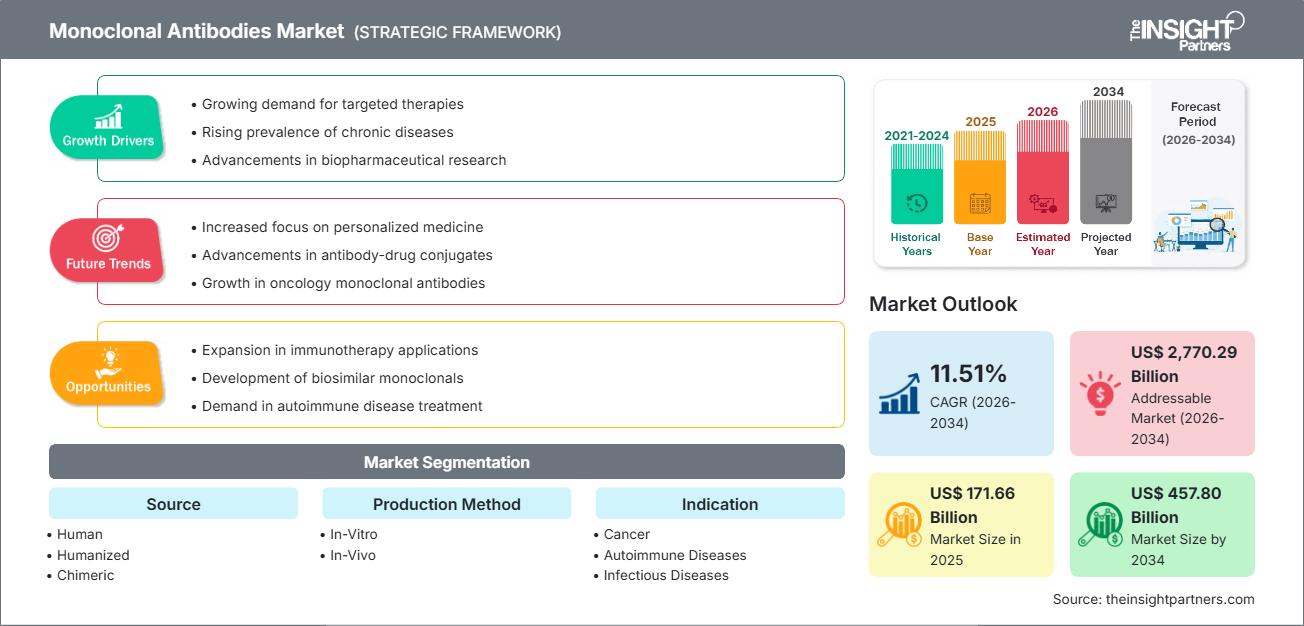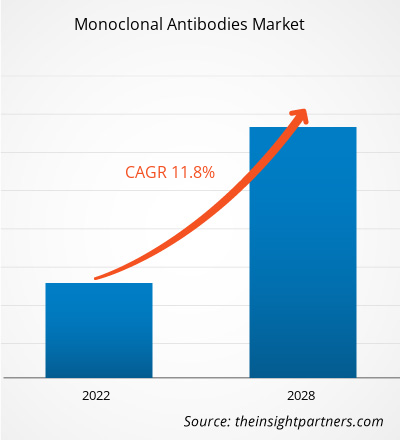Es wird erwartet, dass der Markt für monoklonale Antikörper bis 2034 ein Volumen von 457,80 Milliarden US-Dollar erreichen wird, gegenüber 171,66 Milliarden US-Dollar im Jahr 2025. Für den Zeitraum 2026–2034 wird ein durchschnittliches jährliches Wachstum von 11,51 % prognostiziert.
Marktanalyse für monoklonale Antikörper
Der Markt für monoklonale Antikörper (mAbs) wächst rasant, angetrieben durch die zunehmende Verbreitung chronischer Erkrankungen, Fortschritte in der Biotechnologie und die steigende Nachfrage nach zielgerichteten Therapien. Technologien wie die Hybridom-Technologie, das Phagen-Display und die rekombinante DNA-Technologie werden vermehrt in der Wirkstoffforschung, Diagnostik und Therapie von Onkologie, Autoimmunerkrankungen und Infektionskrankheiten eingesetzt. Pharma- und Biotechnologieunternehmen nutzen mAbs verstärkt, um Behandlungsergebnisse zu verbessern, Nebenwirkungen zu reduzieren und neue Therapieansätze zu entwickeln. Mit dem Aufkommen der personalisierten Medizin, der Entwicklung von Biosimilars und dem verstärkten Einsatz von mAbs bei neu auftretenden Infektionskrankheiten wird ein weiteres rasantes Wachstum des Marktes für monoklonale Antikörper erwartet.
Marktübersicht monoklonaler Antikörper
Der Einsatz monoklonaler Antikörper im Gesundheitswesen trägt zur Steigerung der Wirksamkeit und Spezifität von Therapien bei. Monoklonale Antikörper wirken gezielt gegen spezifische Krankheitsmarker, ermöglichen die Vorhersage des Therapieansprechens, bieten diagnostische Werkzeuge, helfen bei der Erkennung von Krankheitstrends und vieles mehr. Aktuell ist jedes große Pharmaunternehmen in der Forschung und Entwicklung monoklonaler Antikörper (mAbs) tätig. mAb-Therapien werden eingesetzt, um Krankheitsmechanismen zu analysieren und spezifische Antigene gezielt anzugreifen, um Patienten eine personalisierte Behandlung zu ermöglichen. Das Konzept der zielgerichteten Therapie findet hier breite Anwendung. Unternehmen müssen Patienten mit wirksamen Therapien langfristig binden und verstärkt in Forschung und Entwicklung investieren.
Passen Sie diesen Bericht Ihren Anforderungen an.
Sie erhalten eine kostenlose Anpassung aller Berichte – einschließlich Teilen dieser Berichte, Länderanalysen und Excel-Datenpaketen – sowie attraktive Angebote und Rabatte für Start-ups und Universitäten.
Markt für monoklonale Antikörper: Strategische Einblicke

-
Ermitteln Sie die wichtigsten Markttrends dieses Berichts.Diese KOSTENLOSE Probe beinhaltet eine Datenanalyse, die von Markttrends bis hin zu Schätzungen und Prognosen reicht.
Markttreiber und Chancen für monoklonale Antikörper
Markttreiber:
- Zunehmende Verbreitung chronischer Krankheiten: Die weltweit zunehmende Inzidenz von Krebs, Autoimmunerkrankungen und entzündlichen Erkrankungen treibt die Nachfrage nach effektiven und gezielten Therapieoptionen wie monoklonalen Antikörpern an.
- Fortschritte in der Proteintechnik und Biotechnologie: Kontinuierliche Innovationen in der Antikörperentwicklung, Humanisierungstechniken und Expressionssystemen führen zur Entwicklung potenterer, sicherer und neuartiger mAb-Konstrukte mit verbesserter Pharmakokinetik.
- Steigende Investitionen in Forschung und Entwicklung: Erhebliche Investitionen von Pharmaunternehmen und staatlichen Stellen in die Forschung und Entwicklung neuer therapeutischer Antikörper beschleunigen die Arzneimittelforschung und das Marktwachstum.
- Klinischer Erfolg in der Praxis und Patientennachfrage: Die nachgewiesene Wirksamkeit und das verbesserte Sicherheitsprofil monoklonaler Antikörper bei der Behandlung verschiedener Erkrankungen haben zu einer breiten klinischen Anwendung und einer hohen Patientennachfrage geführt, was die Marktexpansion weiter ankurbelt.
Marktchancen:
- Biosimilar-Entwicklung: Der Ablauf der Patente für mehrere Blockbuster-monoklonale Antikörper bietet Biosimilar-Herstellern eine bedeutende Chance, mit erschwinglicheren Alternativen in den Markt einzutreten und so den Patientenzugang und das Marktvolumen zu erhöhen.
- Neue Therapiegebiete: Die Expansion in neue Therapiegebiete wie neurologische Erkrankungen, seltene Krankheiten und Infektionskrankheiten (z. B. COVID-19-Antikörper) bietet ein erhebliches Wachstumspotenzial für die Entwicklung monoklonaler Antikörper.
- Ansätze der personalisierten Medizin: Die Integration monoklonaler Antikörper mit Begleitdiagnostik und biomarkergesteuerten Strategien ermöglicht hochgradig personalisierte Behandlungen, verbessert die Patientenergebnisse und erweitert Marktnischen.
Marktbericht zu monoklonalen Antikörpern: Segmentierungsanalyse
Der Marktanteil monoklonaler Antikörper wird in verschiedenen Segmenten analysiert, um ein besseres Verständnis seiner Struktur, seines Wachstumspotenzials und der sich abzeichnenden Trends zu ermöglichen. Nachfolgend ist der in den meisten Branchenberichten verwendete Standard-Segmentierungsansatz dargestellt:
Laut Quelle:
- Menschlich
- Humanisiert
- Chimäre
- Murine
Nach Produktionsmethode:
- In-vitro
- In-vivo
Nach Indikation:
- Krebs
- Autoimmunerkrankungen
- Infektionskrankheiten
- Entzündliche Erkrankungen
- Mikrobielle Erkrankungen
Auf Antrag:
- Therapeutische Anwendungen
- Diagnostische Anwendungen
- Forschungsanwendungen
Nach Geographie:
- Nordamerika
- Europa
- Asien-Pazifik
- Süd- und Mittelamerika
- Naher Osten und Afrika
Markt für monoklonale Antikörper: Regionale Einblicke
Die regionalen Trends und Einflussfaktoren auf den Markt für monoklonale Antikörper im gesamten Prognosezeitraum wurden von den Analysten von The Insight Partners eingehend erläutert. Dieser Abschnitt behandelt außerdem die Marktsegmente und die geografische Verteilung des Marktes für monoklonale Antikörper in Nordamerika, Europa, Asien-Pazifik, dem Nahen Osten und Afrika sowie Süd- und Mittelamerika.
Berichtsumfang zum Markt für monoklonale Antikörper
| Berichtattribute | Details |
|---|---|
| Marktgröße im Jahr 2025 | 171,66 Milliarden US-Dollar |
| Marktgröße bis 2034 | 457,80 Milliarden US-Dollar |
| Globale durchschnittliche jährliche Wachstumsrate (2026 - 2034) | 11,51 % |
| Historische Daten | 2021-2024 |
| Prognosezeitraum | 2026–2034 |
| Abgedeckte Segmente |
Nach Quelle
|
| Abgedeckte Regionen und Länder |
Nordamerika
|
| Marktführer und wichtige Unternehmensprofile |
|
Marktdichte monoklonaler Antikörper: Auswirkungen auf die Geschäftsdynamik verstehen
Der Markt für monoklonale Antikörper wächst rasant, angetrieben durch die steigende Nachfrage der Endverbraucher. Gründe hierfür sind unter anderem sich wandelnde Verbraucherpräferenzen, technologische Fortschritte und ein wachsendes Bewusstsein für die Vorteile des Produkts. Mit steigender Nachfrage erweitern Unternehmen ihr Angebot, entwickeln innovative Lösungen für die Bedürfnisse der Verbraucher und nutzen neue Trends, was das Marktwachstum zusätzlich beflügelt.

- Verschaffen Sie sich einen Überblick über die wichtigsten Akteure im Markt für monoklonale Antikörper.
Marktanteilsanalyse für monoklonale Antikörper nach Regionen
Nordamerika dominierte den Markt für monoklonale Antikörper. Diese Vormachtstellung der Region gewinnt aufgrund einer robusten Gesundheitsinfrastruktur, hoher Investitionen in Forschung und Entwicklung sowie der Präsenz großer Pharmaunternehmen weiter an Bedeutung. Zudem fördert die US-Regierung aktiv biotechnologische Fortschritte und die Arzneimittelentwicklung. Auch in den aufstrebenden Märkten Süd- und Mittelamerikas, des Nahen Ostens und Afrikas bieten sich Anbietern monoklonaler Antikörper zahlreiche ungenutzte Expansionsmöglichkeiten.
Der Markt für monoklonale Antikörper weist aufgrund von Faktoren wie fortschrittlichen Gesundheitssystemen, regulatorischen Rahmenbedingungen, Krankheitsprävalenz und Investitionen in die biopharmazeutische Forschung in den einzelnen Regionen unterschiedliche Wachstumsverläufe auf. Nachfolgend finden Sie eine Zusammenfassung der Marktanteile und Trends nach Regionen:
1. Nordamerika
- Marktanteil: Besitzt den größten Marktanteil, was auf eine robuste F&E-Infrastruktur, eine hohe Akzeptanz fortschrittlicher Therapien und erhebliche Gesundheitsausgaben zurückzuführen ist.
-
Wichtigste Einflussfaktoren:
- Hohe Prävalenz chronischer Krankheiten wie Krebs und Autoimmunerkrankungen.
- Präsenz führender biopharmazeutischer Unternehmen und Forschungseinrichtungen.
- Ein förderliches regulatorisches Umfeld für die Arzneimittelentwicklung.
- Trends: Fokus auf neuartige Arzneimittelverabreichungssysteme, personalisierte Medizin und Zulassung von Biosimilars.
2. Europa
- Marktanteil: Bedeutender Marktanteil, beeinflusst durch günstige Erstattungspolitiken und ein zunehmendes Bewusstsein für mAb-Therapien.
-
Wichtigste Einflussfaktoren:
- Alternde Bevölkerung und zunehmende Häufigkeit chronischer Krankheiten.
- Regierungsinitiativen zur Förderung pharmazeutischer Innovationen.
- Zunehmende Akzeptanz von Biosimilars aufgrund ihrer Kosteneffizienz.
- Trends: Schwerpunkt auf realweltlichen Erkenntnissen zur Wirksamkeit von Medikamenten und Erweiterung der therapeutischen Indikationen für bestehende monoklonale Antikörper.
3. Asien-Pazifik
- Marktanteil: Der am schnellsten wachsende regionale Markt, angetrieben durch eine verbesserte Gesundheitsinfrastruktur, steigende verfügbare Einkommen und ein zunehmendes Patientenbewusstsein in Ländern wie China, Indien und Japan.
-
Wichtigste Einflussfaktoren:
- Großer Patientenpool und zunehmende Verbreitung chronischer Krankheiten.
- Zunehmende Investitionen in Forschung und Entwicklung im Gesundheitswesen und in der Biopharmabranche.
- Ausbau der inländischen Produktionskapazitäten für monoklonale Antikörper und Biosimilars.
- Trends: Schnelle Einführung von Biosimilars, Fokus auf lokale Arzneimittelentwicklung und verbesserter Zugang zu fortschrittlichen Therapien.
4. Süd- und Mittelamerika
- Marktanteil: Aufstrebende Region mit zunehmender Nutzung fortschrittlicher Therapien aufgrund des verbesserten Zugangs zur Gesundheitsversorgung und des Wirtschaftswachstums.
-
Wichtigste Einflussfaktoren:
- Steigende Gesundheitsausgaben und Modernisierung der Gesundheitssysteme.
- Zunehmende Verbreitung chronischer und infektiöser Krankheiten.
- Bemühungen zur Erweiterung des Zugangs zu innovativen Behandlungsmethoden.
- Trends: Entwicklung lokaler Produktionskapazitäten, Expansion der Biosimilar-Märkte und internationale Kooperationen für den Zugang zu Medikamenten.
5. Naher Osten und Afrika
- Marktanteil: Aufstrebender Markt mit starkem Wachstumspotenzial, angeführt von Gesundheitsreformen und zunehmenden Investitionen im Pharmasektor in Ländern wie den Vereinigten Arabischen Emiraten, Saudi-Arabien und Südafrika.
-
Wichtigste Einflussfaktoren:
- Regierungsinitiativen zur Verbesserung der Gesundheitsversorgung und -infrastruktur.
- Steigendes Bewusstsein und wachsende Nachfrage nach fortschrittlichen Therapieoptionen.
- Strategische Partnerschaften zwischen lokalen und internationalen Pharmaunternehmen.
- Trends: Fokus auf die Entwicklung lokaler biopharmazeutischer Industrien, verstärkte Anwendung zielgerichteter Therapien und die Deckung ungedeckter medizinischer Bedürfnisse.
Marktdichte monoklonaler Antikörper: Auswirkungen auf die Geschäftsdynamik verstehen
Der Markt für monoklonale Antikörper ist durch den verstärkten Wettbewerb zwischen großen globalen Pharma- und Biotechnologieunternehmen sowie aufstrebenden Nischenanbietern und spezialisierten Startups geprägt. Die Unternehmen arbeiten aktiv an Innovationen, um ihre Marktposition zu stärken und die wachsende Nachfrage nach gezielten und wirksamen Therapien für verschiedene Krankheiten zu decken.
Der Wettbewerb zwingt die Anbieter dazu, sich durch Folgendes zu differenzieren:
- Organisationen setzen fortschrittliche Protein-Engineering-Techniken ein, um neuartige mAb-Konstrukte mit verbesserter Wirksamkeit, reduzierter Immunogenität und optimierten Sicherheitsprofilen zu entwickeln.
- Zu den Lösungen gehören heute Kombinationstherapien, die monoklonale Antikörper mit anderen Medikamenten integrieren, wodurch die therapeutische Wirksamkeit erhöht und komplexe Krankheitsmechanismen angegangen werden.
- Angesichts der strengen regulatorischen Anforderungen an die Arzneimittelzulassung und die Patientensicherheit konzentrieren sich Organisationen noch stärker auf robuste klinische Studien und die Überwachung nach der Markteinführung, um die Einhaltung der Vorschriften zu gewährleisten und Vertrauen bei Gesundheitsdienstleistern und Patienten aufzubauen.
Chancen und strategische Schritte
- Pharmaunternehmen nutzen Forschung und Entwicklung, um hochspezifische und wirksame mAb-Therapien für bisher unbehandelbare Krankheiten zu entwickeln und so durch überlegene klinische Ergebnisse und Patentschutz neue Einnahmequellen zu erschließen.
- Durch strategische Partnerschaften, Fusionen und Übernahmen bauen Unternehmen vielfältige Produktpipelines auf, erweitern ihre geografische Reichweite und integrieren neue Technologien für die Wirkstoffforschung und -entwicklung, was zu bedeutenden Investitionen in mAb-Therapien der nächsten Generation führt.
- Große Unternehmen übernehmen entweder kleinere Biotech-Startups oder kooperieren mit ihnen, um innovative Plattformen und spezialisiertes Fachwissen in Bereichen wie bispezifische Antikörper, Antikörper-Wirkstoff-Konjugate (ADCs) und Genomeditierungstechnologien zu gewinnen.
Die wichtigsten Unternehmen, die auf dem Markt für monoklonale Antikörper tätig sind, sind:
- Novartis AG
- Pfizer Inc.
- GlaxoSmithKline plc
- Amgen, Inc
- Daiichi Sankyo Company, Limited
- F. Hoffmann-La Roche AG
- AstraZeneca
- Elli Lilly and Company
- Bayer AG
Hinweis: Die oben aufgeführten Unternehmen sind nicht in einer bestimmten Reihenfolge angeordnet.
Neuigkeiten und aktuelle Entwicklungen auf dem Markt für monoklonale Antikörper
- Beispielsweise präsentierte Novartis am 19. November 2025 im Rahmen einer Late-Breaker-Präsentation auf dem Convergence-Kongress des American College of Rheumatology neue Daten zu Ianalumab bei Morbus Sjögren, der zweithäufigsten rheumatischen Autoimmunerkrankung.
- Am 9. September 2025 gab Novartis die geplante Übernahme von Tourmaline Bio, Inc. bekannt, einem börsennotierten, in New York ansässigen biopharmazeutischen Unternehmen in der klinischen Entwicklungsphase. Tourmaline Bio konzentriert sich auf die Entwicklung von Pacibekitug, einem monoklonalen Anti-IL-6-Antikörper, als Behandlungsoption für atherosklerotische Herz-Kreislauf-Erkrankungen. Pacibekitug ergänzt die Herz-Kreislauf-Strategie von Novartis durch die gezielte Hemmung von IL-6, einem wichtigen Zytokin, das systemische Entzündungen fördert, und adressiert damit einen dringenden medizinischen Bedarf. Da die Phase-21-Studien bereits weit fortgeschritten sind, erwirbt Novartis mit Pacibekitug einen Wirkstoff, der sich in der Phase 3 befindet und das bestehende Portfolio im Bereich der Herz-Kreislauf-Therapien optimal ergänzt.
- Am 7. September 2025 wurde Ifinatamab Deruxtecan als potenzieller First-in-Class B7-H3-gerichteter DXd-Antikörper-Wirkstoff-Konjugat (ADC) entwickelt. Es wurde von Daiichi Sankyo entdeckt und wird gemeinsam von Daiichi Sankyo und Merck & Co., Inc., Rahway, NJ, USA, außerhalb der Vereinigten Staaten und Kanadas als MSD bekannt, weiterentwickelt.
Marktbericht zu monoklonalen Antikörpern: Abdeckung und Ergebnisse
Der Bericht „Marktgröße und Prognose für monoklonale Antikörper (2021–2034)“ bietet eine detaillierte Analyse des Marktes und deckt folgende Bereiche ab:
- Marktgröße und Prognose für monoklonale Antikörper auf globaler, regionaler und Länderebene für alle wichtigen Marktsegmente, die im Rahmen des Berichts abgedeckt werden
- Markttrends für monoklonale Antikörper sowie Marktdynamiken wie Treiber, Hemmnisse und wichtige Chancen
- Detaillierte PEST- und SWOT-Analyse
- Marktanalyse für monoklonale Antikörper: Wichtige Markttrends, globale und regionale Rahmenbedingungen, Hauptakteure, regulatorische Bestimmungen und aktuelle Marktentwicklungen
- Branchenlandschaft und Wettbewerbsanalyse mit Fokus auf Marktkonzentration, Heatmap-Analyse, führende Akteure und aktuelle Entwicklungen im Markt für monoklonale Antikörper. Detailliertes Unternehmensprofil.
- Historische Analyse (2 Jahre), Basisjahr, Prognose (7 Jahre) mit CAGR
- PEST- und SWOT-Analyse
- Marktgröße Wert/Volumen – Global, Regional, Land
- Branchen- und Wettbewerbslandschaft
- Excel-Datensatz
Aktuelle Berichte
Erfahrungsberichte
Grund zum Kauf
- Fundierte Entscheidungsfindung
- Marktdynamik verstehen
- Wettbewerbsanalyse
- Kundeneinblicke
- Marktprognosen
- Risikominimierung
- Strategische Planung
- Investitionsbegründung
- Identifizierung neuer Märkte
- Verbesserung von Marketingstrategien
- Steigerung der Betriebseffizienz
- Anpassung an regulatorische Trends






















 Kostenlose Probe anfordern für - Markt für monoklonale Antikörper
Kostenlose Probe anfordern für - Markt für monoklonale Antikörper